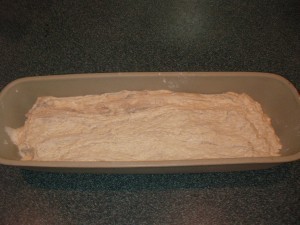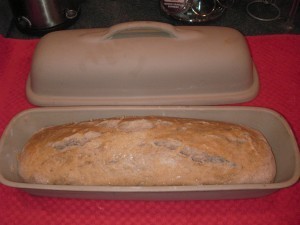CHUsday and Bread's Baking in the Oven
 If you've tuned in for the first time, you can read all about CHUsday and my monthly giveaway here. Or go to Cookbook Hoarders United under categories and see what we've been doing.
If you've tuned in for the first time, you can read all about CHUsday and my monthly giveaway here. Or go to Cookbook Hoarders United under categories and see what we've been doing.
The comments have slacked off, so if you're pulling out old cookbooks, you're not telling me and entering the giveaway. Why not make something by the end of the month, tell us what you made and how it went, and enter for September's autographed book and silly kitchen gadget (Yolky, the amazing egg separator.) Kids are back in school and it's autumn. Think soups, or stews, or maybe hot apple pie. There's always a wonderful casserole you've yet to discover.
Several years ago my youngest son gave me a new bread book, Artisan Bread in Five Minutes A Day by Hertzberg and Francois. He knew how much I love to make bread, and he thought this would be a fun new addition. I thought so, too, only I had my own bread ritual, and never quite got into this radically different approach.
Then this summer friends in New York gave us a wonderful Le Creuset 5 1/2 quart round French oven, much like the one I've linked to here at Amazon. This was the perfect pan to try Artisan bread, so my husband decided to give it a whirl, despite not having the cookbook with us. Michael likes to cook, but he'd never before made bread. A quick Internet search found a similar recipe for Sullivan bread from the NY Times, and off he went. The resulting bread was so good, we were hooked.
Once we returned home, Michael pulled out the Artisan Bread cookbook (Hoarder alert) and read the instructions. I'd already bought the 6 quart plastic container to store the dough in the fridge, (Hoarder alert #2) even though I hadn't used it for that, and I'd also bought a clay pot with a lid (Alert #3) that turned out to be the perfect pan for a long Artisan loaf. I must have known, right?
King Arthur must have known, too, because the pan I've linked to is MUCH more expensive now. Motto: Sometimes hoarding pays.
The fun part of Artisan bread is that you simply mix the ingredients–lots of flour to make lots of bread–then after a brief sojourn on your counter, you store it in a covered contained in the fridge. No kneading, no prolonged rising and punching down. You then use the dough to make bread for the next two weeks. Michael made his first loaf, small, round and perfect, the next day, and unfortunately we forgot to take a photo. The one pictured here–dough stage first, then baked–was the second, and higher than it looks in the photo.
This bread is delicious, nothing like my more traditional loaves, but chewy and flavorful, perfect with those soups and stews I mentioned before. We're finishing the first batch of dough tomorrow when I make a pot of vegetable soup and spaetzle. There are lots of options in the cookbook, so Michael will probably try something different, but the one pictured is the Peasant Bread, with a little rye and a little whole wheat. Like all cooking, there's a learning curve, but even the mistakes have turned out. This method truly is nearly foolproof.
I highly recommend this cookbook. Very definitely worth hoarding. If you've never been successful making bread, this is the book for you.



